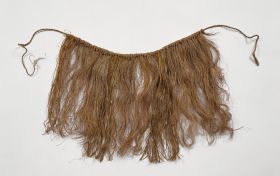Skirt
Place: Tahiti & Society Islands
Category: Clothing
plant fibre, Tahiti and the Society Islands, l. 30 cm, Inv. Oz 425
Humphrey No.47: ‘an apron worn by the Girls of the Society Isles by way of Fig-leaf, being all the Clothing they have on, in their Heivas or Dances, formed of fine white Shred of the Plantain leaf, some of them dyed yellow, and knotted to a String which fastens it round the Waist.’ (probably Oz 420); Forster (?) (= Oz 425)
One of three skirts made with plant fibres gathered together into little bundles and knotted into a two-piece twisted string of the same material. The fibre bundles have a golden to light-brown colour which is probably of natural origin. The fibre material presumably comes from the purau tree (Hibiscus tiliaceus) (cf. Henry 1928: 53f.).
With the exception of the lavishly-made dance costumes as depicted e.g. by John Webber (cf. Joppien/Smith 1988, III: 359), the dance costumes of the women and girls were usually grass skirts (cf. Bunzendahl 1935:137). Comparable pieces almost identical to the three skirts were listed by Augustin (1993: 111) for Wörlitz and Herrnhut. Gundolf Krüger
Sources
Augustin, Stephan, Kunstsachen von Cooks Reisen - Die Sammlung und ihre Geschichte im Völkerkundemuseum Herrnhut, Museum für Völkerkunde, Dresden, 1993.
Bunzendahl, Otto, Tahiti und Europa: Entdeckungsgeschichte der Gesellschaftsinseln, Studien zur Völkerkunde, Leipzig, 1935, vol. 8,.
Henry, Teuira, Ancient Tahiti, Bernice P Bishop Museum Bulletin, Honolulu, 1928, vol. 48.
Joppien, Rudiger and Smith, Bernard, The Art of Captain Cook’s Voyages, 3 vols in 4 parts, New Haven and London, 1985-1988.
Related artefacts
Skirt, Hanover 1954, No. 12
Skirt, Inv. Oz 420

